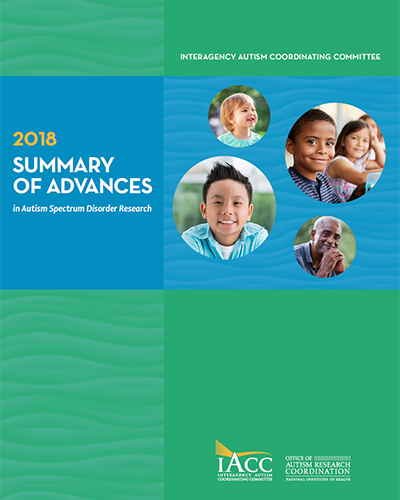Archives
Summary of Advances
In Autism Spectrum Disorder Research
2018
Articles Selected for the 2018 Summary of Advances
Question 1: How Can I Recognize The Signs Of ASD, and Why Is Early Detection So Important?
- EEG analytics for early detection of autism spectrum disorder: a data-driven approach
- Automatic emotion and attention analysis of young children at home: a ResearchKit autism feasibility study
- A longitudinal study of parent-reported sensory responsiveness in toddlers at-risk for autism
Question 2: What Is the Biology Underlying ASD?
- Neuron numbers increase in the human amygdala from birth to adulthood, but not in autism
- Complete disruption of autism-susceptibility genes by gene editing predominantly reduces functional connectivity of isogenic human neurons
- Social deficits in Shank3-deficient mouse models of autism are rescued by histone deacetylase (HDAC) inhibition
Question 3: What Causes ASD, and Can Disabling Aspects of ASD be Prevented or Preempted?
- Analysis of shared heritability in common disorders of the brain
- Paternally inherited cis-regulatory structural variants are associated with autism
- Shared molecular neuropathology across major psychiatric disorders parallels polygenic overlap
- Transcriptome-wide isoform-level dysregulation in ASD, schizophrenia, and bipolar disorder
- De novo mutations in regulatory elements in neurodevelopmental disorders
Question 4: Which Treatments and Interventions Will Help?
- Cluster randomized trial of the classroom SCERTS intervention for elementary students with autism spectrum disorder
- Meta-analysis of parent-mediated interventions for young children with autism spectrum disorder
- Are children severely affected by autism spectrum disorder underrepresented in treatment studies? An analysis of the literature
Question 5: What Kinds Of Services and Supports are Needed To Maximize Quality Of Life For People On The Autism Spectrum?
- Effects of state autism mandate age caps on health service use and spending among adolescents
- Vaccination patterns in children after autism spectrum disorder diagnosis and in their younger siblings
Question 6: How Can We Meet The Needs Of People With ASD as They Progress Into and Through Adulthood?
- Autism spectrum disorder symptoms from ages 2 to 19 years: implications for diagnosing adolescents and young adults
- Psychiatric and medical conditions in transition-aged Individuals with ASD
- Understanding service usage and needs for adults with ASD: the importance of living situation
Question 7: How Do We Continue To Build, Expand, and Enhance the Infrastructure System To Meet the Needs of the ASD Community?
- Prevalence of autism spectrum disorder among children aged 8 years — Autism and Developmental Disabilities Monitoring Network, 11 sites, United States, 2014.




